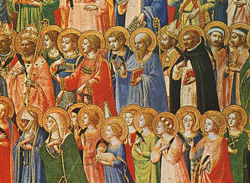
We celebrate his day on Oct. 18.
“1Since many have undertaken to set down an orderly account of the events that have been fulfilled among us, 2 just as they were handed on to us by those who from the beginning were eyewitnesses and servants of the word, 3 I too decided, after investigating everything carefully from the very first, to write an orderly account for you, most excellent Theophilus, 4 so that you may know the truth concerning the things about which you have been instructed.” – Luke: 1:1-4
Many scholars believe that Luke was a Greek physician who lived in the Greek city of Antioch in Ancient Syria and thus considered a Gentile unlike the other Gospel authors.
He is the writer of both the Gospel of Luke and Acts. These total 24% of the New Testament and thus he wrote more of the New Testament than any other author, including Paul.
Luke made major contributions in revealing Jesus in Luke and Acts. These parables are solely in Luke:
The Birth of John the Baptist Foretold (1:5-25)
The Birth of Jesus Foretold (1:26-38)
The Visitation (1:39-56)
The Birth of John the Baptist (1:57-80)
The Circumcision and Presentation of Jesus (2:21-40)
The Finding in the Temple (2:41-52)
The Widow of Nain’s Son (7:11-17)
The Mission of the Seventy (10:01-20)
The Good Samaritan (10:29-37)
“Mary has chosen the good portion” (10:38-42)
The Friend at Midnight (11:5-8)
The Parable of the Rich Fool (12:13-21)
The Parable of the Lost Coin (15:8-10)
The Parable of the Lost Son (15:11-32)
The Parable of the Shrewd Steward (16:1-8)
Lazarus and the Rich Man (16:19-31)
Ten Lepers Cleansed (17:11-19)
The Parable of the Persistent Widow (18:1-8)
The Parable of the Pharisee and the Tax Collector (18:9-14)
Dinner with Zacchaeus (19:1-10)
Who Is the Greatest? (22:24-32)
Jesus Before Herod Antipas (23:6-12)
He never met Christ in person, but in his Gospel he says that he came to know about Jesus by talking to eyewitnesses to the events of Jesus’ life, death, and Resurrection.
Given the similarities that Luke has to Matthew and Mark (the other two Synoptic Gospels), it is likely that he used one or both of these.
One of the eyewitnesses he likely interviewed was the Virgin Mary herself. Luke records the material in the infancy narrative in a way that implies Mary was the source of much or all of it
Another one of his sources was Paul. One way of showing this is that the words of institution for the Eucharist in Luke’s Gospel (see Luke 22:19-20) is very similar to the formula used by Paul (see 1 Cor. 11:24-25). It is less similar to the formula used in Matthew and Mark (see Matt. 26:26-28, Mark 14:22-24)
Luke was a doctor and he traveled with Paul on his second missionary journey. In fact, Paul calls Luke his “beloved physician” (Colossians 4:14). He was the one person who was said to have remained with Paul during his imprisonment and until his death.
Because he cared for the bodily needs of others, Luke is the patron saint of doctors. He is also the patron saint of artists because it is believed that he painted a famous portrait of Mary.
The symbol for Luke’s Gospel is an ox, an animal that was often sacrificed as an offering to God in ancient times. In his writings about Jesus, Luke reminds us of the great sacrifice Jesus made to save all people through his death on the cross and his Resurrection.
St. Luke is mentioned by name in three passages of Scripture and thus is more evidence that he was a frequent companion of Paul:
- In Colossians 4:14, St. Paul writes: “Luke the beloved physician and Demas greet you.”
- In 2 Timothy 4:11, Paul writes: “Luke alone is with me. Get Mark and bring him with you; for he is very useful in serving me.”
- And in Philemon 23-24, Paul writes: “Epaphras, my fellow prisoner in Christ Jesus, sends greetings to you, and so do Mark, Aristarchus, Demas, and Luke, my fellow workers.”



